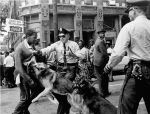MIAMI (AP)—Bill Hudson, an Associated Press photographer whose searing images of the civil rights era documented police brutality and galvanized the public, died June 24 in Jacksonville, Fla. He was 77.
Hudson was in Birmingham, Ala., when Black demonstrators defied a city ban on protests in 1963, and police turned their dogs on marchers, and again in Selma, Ala., when fire hoses were officers’ weapon of choice.
 |
| ENDURING IMAGE—In this May 3, 1963 photo, a 17-year-old civil rights demonstrator, defying an anti-parade ordinance of Birmingham, Ala., is attacked by a police dog.
|
Most enduring of Hudson’s portfolio is a May 3, 1963, image of an officer in dark sunglasses grabbing a young Black man by his sweater as he lets a police dog bury its teeth into the youth’s stomach. The young man, Walter Gadsden, has his eyes lowered, with a look of passive calm.
In more than three decades of photojournalism, Hudson chronicled the Korean War as an Army photographer and bodies destined for autopsies at the Dade County Medical Examiner. But his most profound work came in his coverage of the Civil Rights Movement in the 1960s.
The AP photograph of the police dog and boy appeared above the fold in The New York Times the next day, across three columns, and undoubtedly in numerous other papers. Many came to see it as a force in galvanizing public opinion on behalf of the civil rights advocates.
Hudson’s wife said her husband encountered a great deal of animosity from those who didn’t want him documenting the fights.
“Sometimes they were hiding in trash cans,” she said, “and sometimes people were throwing rocks and bricks at him.”
In “Carry Me Home,” Diane McWhorter’s 2001 book about the civil rights era in Birmingham, the author refers nine times to the photograph, saying it helped move “international opinion to the side of the civil rights revolution.”
Phil Sandlin, who documented the Civil Rights Movement for United Press International before joining AP, said Hudson looked out for him despite working for a competitor.
“He was probably the most feared photographer that I had to work against because he was very, very good,” Sandlin said. “He was very cool, he didn’t get rattled. He was a good person to work with despite the fact that we were competitors.”
Hudson was born Aug. 20, 1932, in Detroit and began his photographic career in the Army in 1949. He later shot photos for the Press-Register of Mobile, Ala., and the Chattanooga Times before joining the AP in Memphis, Tenn., in 1962. He left the AP in 1974, joining UPI.